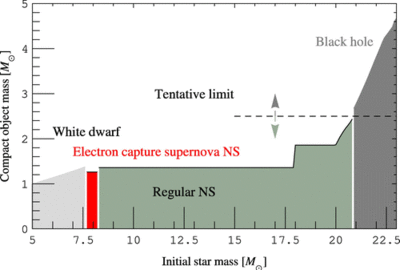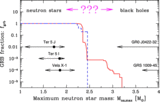Image Details

Caption: Fig. 2.
Initial (zero‐age main sequence) mass to final compact object mass relation for single stars. This represents our current understanding of compact object formation. Stars below about ﹩7.5\,M_{\odot }﹩ form white dwarfs; stars in the narrow range around ﹩8\,M_{\odot }﹩ can potentially form very light neutron stars through electron capture supernovae (Podsiadlowski et al. 2004). More massive stars show a well‐defined bifurcation caused by different modes of energy transport in the stellar core: stars below ﹩18\,M_{\odot }﹩ form light neutron stars (![]() ﹩1.35\,M_{\odot }﹩), while stars above this mass form heavy neutron stars (
﹩1.35\,M_{\odot }﹩), while stars above this mass form heavy neutron stars (![]() ﹩1.8\,M_{\odot }﹩). Above
﹩1.8\,M_{\odot }﹩). Above ![]() ﹩20\,M_{\odot }﹩ stars experience partial fallback of material that can turn nascent neutron stars into black holes. Compact objects originating from stars of ~﹩20{\mbox{--}} 22\,M_{\odot }﹩ form either very heavy neutron stars or low‐mass black holes depending on the unknown limiting mass between these two remnant types (expected to lie around ﹩2{\mbox{--}} 3\,M_{\odot }﹩).
﹩20\,M_{\odot }﹩ stars experience partial fallback of material that can turn nascent neutron stars into black holes. Compact objects originating from stars of ~﹩20{\mbox{--}} 22\,M_{\odot }﹩ form either very heavy neutron stars or low‐mass black holes depending on the unknown limiting mass between these two remnant types (expected to lie around ﹩2{\mbox{--}} 3\,M_{\odot }﹩).
Copyright and Terms & Conditions
© 2008. The American Astronomical Society. All rights reserved. Printed in U.S.A.






